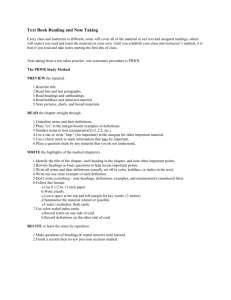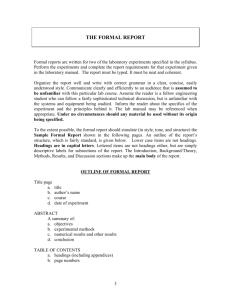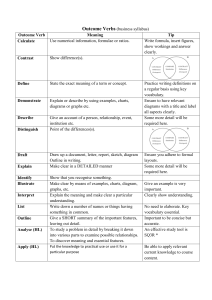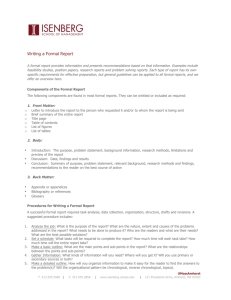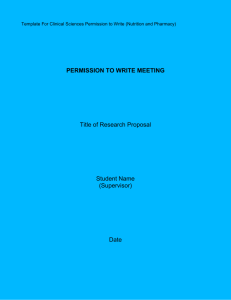Successful Textbook Reading and Note Taking
advertisement
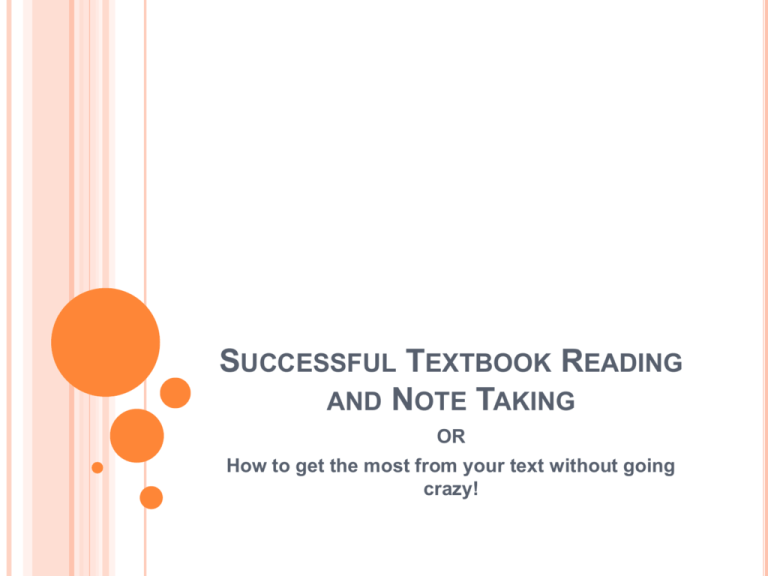
SUCCESSFUL TEXTBOOK READING AND NOTE TAKING OR How to get the most from your text without going crazy! INFORMATION OVERLOAD!!! When you first open a textbook, especially for a complex subject, it can be very intimidating. The idea that you have to look at all this information and pick out the important parts is overwhelming. DON’T PANIC! There are a few different tricks and tools that you can use to make this easier. Find out what you need to know. Examine the pictures and headings. Read and take notes on one subheading at a time. Take Breaks and walk around. Don’t try to do the whole thing in one long cram session. Use page isolators or magnifiers if you need them. FIND OUT WHAT YOU NEED TO KNOW. In most textbooks, there are items that help you pinpoint the important sections of the chapter. Objectives, glossaries, and review questions all show you what is meant to be taken from the chapter. Examine these first, and you will often get a clear idea of what subjects to watch for in the reading. As you take your notes, you will write down the answers or definitions for these topics as you read. EXAMINE THE PICTURES AND HEADINGS. Now that you know what is important here, you can use the pictures and sub-headings to get an idea of the order that topics are covered. Just take a quick glance through the reading to see what is coming. You can use those headings as the main points in an outline format for your notes if you wish. READ AND TAKE NOTES ON ONE SUBHEADING AT A TIME. Don’t try to tackle the entire reading at one time and then take notes, you will forget a lot and absorb very little. Work one sub-heading at a time. After reading one section, stop and write down your thoughts and answers to any of the objective/review questions you found. This will help you keep the material due to the writing process. It will also help keep your notes organized. Next move onto another section and repeat. TAKE BREAKS AND WALK AROUND. DON’T TRY TO DO THE WHOLE THING IN ONE LONG CRAM SESSION. Your eyes, brain, and body are not designed to maintain the same position and focus for hours at a time. You need to move around and take breaks. Every hour that you are working, you should get up for 10 minutes and do something else. This could be a walk around the block, talk to your family, stretch , or other movement. If you do this, you should find that you are much more alert and focused. USE PAGE ISOLATORS OR MAGNIFIERS IF YOU NEED THEM. Sometimes when I am trying to read a book, there is so much text on the page that I am constantly losing my place. If I use a page isolator, this helps block the parts of the page that I am not focused on right now. Other times, the text is just to small or dark. In these cases a text magnifier can enlarge the text to a comfortable size for much easier reading. TAKING HELPFUL NOTES There are many different methods for taking notes, and it is your choice which method works for you. Sample Methods: Two Page Method Cornell Method Note Cards Brain Storming Maps TWO PAGE METHOD In this method of note taking, you will use 2 pieces of paper at a time. Lay the two pieces side by side, and label them both with the same page number and date. On the right sheet, you will record your general notes about the reading or lecture. On the left sheet, you can include questions you want to ask, key words, dates and times, or any information that should have been in an earlier section of the main notes page. When you are done, flip to another page, and use the back of the right page as the left page for the next set of notes. CORNELL METHOD NOTE CARDS This method of note taking is very similar to using flash cards as a memory tool. While reading or listening to a lecture, you can write each topic or concept on a note card. The explanation or info about that topic then goes on the other side. This note has the benefit of working really well when you have already done the reading. You can get ready for the class by writing out the main headings as topics, then you are ready to record notes when that topic is covered. BRAIN STORMING MAP With a brain map, you are creating a visual setup that helps to explain the relationships between concepts and the main topic. This method can be helpful for people who find the typical note taking style to be frustrating. CONCLUSION While textbooks and note taking can be very difficult to get used to, there are many things that you can do to make it easier. The ones that I have listed here are just the start. Take time and ask others if you can see their notes or ask how they try to do the reading. Try different things until you find a style that helps you!



